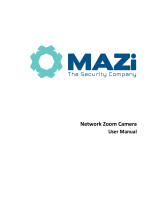
User Manual of Network Camera
© Hikvision Digital Technology Co., Ltd. All Rights Reserved.
6.4 CONFIGURING VIDEO AND AUDIO SETTINGS ..................................................................................... 46
6.4.1 Configuring Video Settings ................................................................................................ 46
6.4.2 Configuring Audio Settings ................................................................................................ 47
6.4.3 Configuring ROI Encoding .................................................................................................. 48
6.5 CONFIGURING IMAGE PARAMETERS ................................................................................................ 48
6.5.1 Configuring Display Settings .............................................................................................. 48
6.5.2 Configuring OSD Settings ................................................................................................... 50
6.5.3 Configuring Text Overlay Settings ...................................................................................... 52
6.5.4 Configuring Privacy Mask .................................................................................................. 52
6.5.5 Configuring Picture Overlay ............................................................................................... 53
6.6 CONFIGURING AND HANDLING ALARMS .......................................................................................... 54
6.6.1 Configuring Motion Detection ........................................................................................... 54
6.6.2 Configuring Tamper-proof Alarm ....................................................................................... 57
6.6.3 Configuring External Alarm Input ...................................................................................... 59
6.6.4 Configuring Alarm Output ................................................................................................. 60
6.6.5 Handling Exception ............................................................................................................ 61
6.6.6 Email Sending Triggered by Alarm ..................................................................................... 62
6.6.7 Configuring Snapshot Settings ........................................................................................... 63
6.6.8 Face Detection ................................................................................................................... 64
6.6.9 Configuring Other Alarms .................................................................................................. 65
6.6.10 Arming or Disarming the Camera .................................................................................. 70
CHAPTER 7 STORAGE SETTINGS .................................................................................................. 72
7.1 CONFIGURING NAS SETTINGS ....................................................................................................... 72
7.2 CONFIGURING RECORDING SCHEDULE ............................................................................................. 73
CHAPTER 8 PLAYBACK ................................................................................................................ 78
CHAPTER 9 LOG SEARCHING ....................................................................................................... 80
CHAPTER 10 OTHERS .................................................................................................................... 81
10.1 MANAGING USER ACCOUNTS ........................................................................................................ 81
10.2 CONFIGURING RTSP AUTHENTICATION ........................................................................................... 83
10.3 ANONYMOUS VISIT ..................................................................................................................... 83
10.4 IP ADDRESS FILTER ...................................................................................................................... 84
10.5 VIEWING DEVICE INFORMATION .................................................................................................... 86
10.6 MAINTENANCE ........................................................................................................................... 87
10.6.1 Rebooting the Camera ................................................................................................... 87
10.6.2 Restoring Default Settings ............................................................................................. 87
10.6.3 Importing/Exporting Configuration File ........................................................................ 87
10.6.4 Upgrading the System .................................................................................................... 88
10.7 RS-232 SETTINGS ...................................................................................................................... 88
10.8 RS-485 SETTINGS ...................................................................................................................... 89
APPENDIX ........................................................................................................................................ 90
APPENDIX 1 SADP SOFTWARE INTRODUCTION ............................................................................................. 90




















